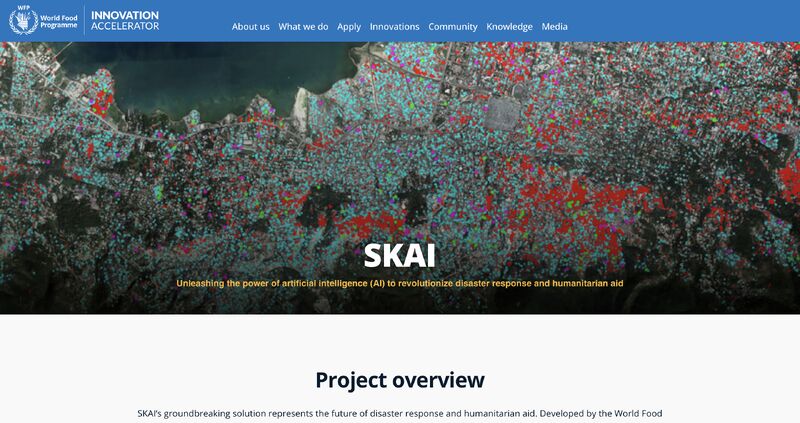Table of Contents
- Introduction to Artificial Intelligence in Humanitarian Aid
- The potential impact of AI in humanitarian aid
- Using AI for disaster response and early warning systems
- AI applications in healthcare and public health services
- Enhancing efficiency in aid distribution and resource allocation with AI
- Ethical considerations and challenges in using AI for humanitarian aid
- Collaboration and partnerships in leveraging AI for humanitarian efforts
- Future developments and trends in AI for humanitarian aid
Artificial intelligence (AI) has the potential to revolutionize the way humanitarian aid is delivered, from predicting and preventing crises to optimizing relief operations. As the demand for humanitarian aid continues to grow, organizations are turning to AI to harness its power in order to improve the effectiveness and efficiency of their efforts. In this article, we will explore the various ways in which AI can be used in humanitarian aid, the challenges and opportunities it presents, and the potential impact it can have on the lives of those in need.
Introduction to Artificial Intelligence in Humanitarian Aid
Artificial Intelligence (AI) has the potential to revolutionize the field of humanitarian aid by providing innovative solutions to complex challenges faced in disaster response, refugee assistance, and poverty alleviation. The use of AI in humanitarian aid can significantly improve the efficiency, accuracy, and timeliness of emergency relief efforts, leading to more effective outcomes for affected populations. The application of AI technologies in this context can range from data analysis and predictive modeling to robotics and autonomous systems for delivering aid.
In the context of the "Unleashing the Power of Artificial Intelligence in Humanitarian Aid", the introduction to AI in humanitarian aid aims to provide a comprehensive overview of the potential uses of AI in addressing humanitarian crises. This section will cover key concepts related to AI, such as machine learning, natural language processing, and computer vision, and how these technologies can be harnessed to support humanitarian efforts. Additionally, it will explore case studies and examples of how AI has been successfully utilized in humanitarian aid projects around the world.
The "Introduction to Artificial Intelligence in Humanitarian Aid" section will also highlight the ethical and practical considerations of using AI in humanitarian contexts, including issues related to data privacy, bias, and transparency. Overall, it will serve as a foundational guide for understanding the role of AI in improving the delivery of humanitarian aid.
The potential impact of AI in humanitarian aid
- Effective resource allocation: AI can analyze vast amounts of data to identify regions and communities most in need of aid, ensuring that resources are allocated in the most efficient and impactful way.
- Early warning and response: AI-powered analytics can detect early signs of natural disasters or conflict, allowing humanitarian organizations to mobilize response efforts more quickly and potentially save more lives.
- Improved decision-making: AI can assist aid workers in making more informed decisions by providing data-driven insights and predictions, ultimately leading to better outcomes for those in need.
- Enhanced communication and coordination: AI can facilitate communication and coordination among different humanitarian organizations, helping to streamline efforts and avoid duplication of services.
- Increased access to services: AI technologies such as chatbots and virtual assistants can provide information and support to people in need, especially in remote or underserved areas where access to traditional aid services may be limited.
- Data analysis for long-term impact: AI can analyze historical and real-time data to identify trends and patterns, helping humanitarian organizations better understand and address the root causes of crises for long-term impact.
Overall, the potential impact of AI in humanitarian aid is significant, offering opportunities to enhance the efficiency, effectiveness, and reach of aid efforts, ultimately improving the lives of those affected by crises and disasters.
Using AI for Disaster Response and Early Warning Systems
Artificial Intelligence (AI) has the potential to greatly improve disaster response and early warning systems in humanitarian aid efforts. By leveraging AI technologies, such as machine learning and predictive analytics, organizations can enhance their ability to predict and prepare for natural disasters, as well as respond effectively when disasters occur.
Applications of AI in Disaster Response and Early Warning Systems
- Predictive Analysis: AI can analyze historical data, weather patterns, and other relevant information to predict the likelihood and impact of natural disasters, such as hurricanes, earthquakes, and floods.
- Real-Time Monitoring: AI-powered sensors and drones can provide real-time monitoring of disaster-affected areas, enabling aid organizations to assess the situation quickly and accurately.
- Resource Allocation: AI can optimize the allocation of resources by analyzing data on affected populations, infrastructure damage, and other factors to allocate aid and relief efforts more efficiently.
- Decision Support Systems: AI can assist decision-makers in prioritizing response efforts and coordinating rescue operations by providing valuable insights and recommendations.
Benefits of AI in Humanitarian Aid
- Improved early warning and response capabilities
- Enhanced data analysis and decision-making
- Better coordination of relief efforts
- Increased efficiency and effectiveness of humanitarian aid operations
By harnessing the power of AI, humanitarian organizations can better prepare for and respond to disasters, ultimately saving lives and minimizing the impact of natural disasters on vulnerable populations.
AI applications in healthcare and public health services
The potential of artificial intelligence (AI) in healthcare and public health services is vast, offering opportunities for improved patient care, preventive medicine, and disease outbreak management. AI applications in these areas include:
-
Disease detection and diagnosis: AI technologies can analyze medical images, such as X-rays and MRIs, to identify potential diseases and conditions with a high level of accuracy. This can lead to quicker and more effective diagnosis, ultimately improving patient outcomes.
-
Precision medicine: AI can analyze vast amounts of patient data to identify personalized treatment plans based on individual genetic profiles, lifestyle factors, and medical history. This can lead to more targeted and effective treatments, reducing the risk of adverse reactions and improving overall health outcomes.
-
Predictive analytics: AI can analyze large datasets to identify patterns and trends in public health, predicting disease outbreaks and enabling timely responses to prevent the spread of illnesses.
-
Telemedicine: AI-powered chatbots and virtual assistants can provide medical advice and support to individuals, especially in remote or underserved areas, improving access to healthcare services.
These AI applications have the potential to significantly impact humanitarian aid efforts by providing more effective and efficient healthcare and public health services to those in need. By leveraging AI, humanitarian organizations can enhance their capacity to address global health challenges and improve the overall well-being of communities.
Enhancing efficiency in aid distribution and resource allocation with AI
Artificial Intelligence (AI) plays a crucial role in optimizing aid distribution and resource allocation in humanitarian aid efforts. By leveraging AI technologies, organizations can enhance the efficiency and effectiveness of their operations in several ways:
-
Data analysis: AI can process large volumes of data from various sources to identify patterns, trends, and correlations that can inform aid distribution decisions. This allows organizations to prioritize areas and populations in need of assistance more accurately.
-
Predictive analytics: AI algorithms can forecast and anticipate future humanitarian crises, helping organizations proactively allocate resources and prepare for potential disasters.
-
Optimization of logistics: AI can optimize supply chain and logistics management, enabling organizations to streamline the delivery of aid and minimize waste.
-
Resource allocation: AI can assist in identifying the most effective allocation of resources, such as medical supplies, food, and shelter, based on real-time data and conditions on the ground.
-
Risk assessment: AI can assess and mitigate risks associated with aid distribution, such as security threats or infrastructure challenges, to ensure the safety and effectiveness of operations.
Moreover, AI can enable better coordination and collaboration among humanitarian organizations, allowing for the seamless sharing of data and resources to maximize impact. Overall, the integration of AI in humanitarian aid has the potential to revolutionize aid distribution and resource allocation, ultimately increasing the efficacy and reach of humanitarian efforts.
Ethical considerations and challenges in using AI for humanitarian aid
Ethical considerations:
- Informed consent: AI technologies often involve data collection and analysis, raising concerns about the informed consent of the individuals whose data is being used.
- Bias and fairness: AI algorithms may perpetuate existing biases and inequalities, leading to unfair treatment of certain groups or individuals.
- Privacy and data protection: The use of AI in humanitarian aid may involve sensitive personal information, making it crucial to ensure data privacy and protection.
Challenges:
- Lack of transparency: The complex nature of AI systems may make it difficult to understand their decision-making process, raising concerns about accountability and transparency.
- Technical limitations: AI technologies may not always be reliable or accurate, especially in the context of humanitarian aid where the stakes are high.
- Resource constraints: Deploying AI solutions in humanitarian aid settings may be challenging due to limited resources and infrastructure.
Mitigation strategies:
- Ethical guidelines and frameworks: Developing and adhering to ethical guidelines and frameworks can help address the ethical considerations and challenges associated with AI in humanitarian aid.
- Diversity and inclusion: Ensuring diversity and inclusion in the development and deployment of AI technologies can help mitigate bias and unfair treatment.
-
Collaboration and partnerships: Collaborating with local communities, governments, and other stakeholders can help address technical and resource-related challenges in using AI for humanitarian aid.
Collaboration and Partnerships in Leveraging AI for Humanitarian Efforts
In the realm of humanitarian aid, the collaboration and partnerships formed in leveraging AI are crucial for effectively addressing the complex challenges faced by communities in need. By bringing together organizations, governments, and technology experts, the potential of AI for humanitarian efforts can be maximized. This collaboration enables the sharing of resources, expertise, and data, leading to more impactful and sustainable solutions.
Partnerships between humanitarian organizations and technology companies can provide access to advanced AI tools and expertise that may not be readily available within the humanitarian sector. These collaborations can facilitate the development of AI-driven solutions for disaster response, early warning systems, and data analysis to inform decision-making.
Furthermore, partnerships can also involve academia and research institutions, bringing cutting-edge research and innovation to the forefront of humanitarian efforts. By integrating academic expertise into the development and implementation of AI solutions, humanitarian organizations can ensure that their interventions are informed by the latest scientific knowledge and best practices.
The private sector also plays a pivotal role in leveraging AI for humanitarian aid, with partnerships between tech companies and humanitarian organizations resulting in the deployment of AI technologies and systems that enhance the efficiency and effectiveness of aid delivery.
Overall, collaboration and partnerships in leveraging AI for humanitarian efforts not only foster innovation but also ensure that the benefits of AI are effectively harnessed to address the needs of vulnerable communities. Through these partnerships, the humanitarian sector can unlock the full potential of AI for humanitarian aid.
Future developments and trends in AI for humanitarian aid
As technology continues to advance, it is expected that Artificial Intelligence (AI) will play an increasingly important role in humanitarian aid, revolutionizing the way organizations respond to crises and provide assistance to those in need. Some future developments and trends in AI for humanitarian aid include:
-
Enhanced predictive analytics: AI can be used to analyze large amounts of data to predict and identify potential humanitarian crises, allowing organizations to take proactive measures to mitigate their impact.
-
Improved decision-making: AI algorithms can assist aid workers in making more informed decisions by analyzing complex and dynamic situations and providing real-time recommendations.
-
Automation of repetitive tasks: AI-powered systems can automate routine tasks such as data entry, logistics planning, and resource allocation, allowing aid workers to focus on more critical aspects of their work.
-
Natural language processing: AI technologies will continue to improve in understanding and interpreting human language, facilitating communication between aid workers and affected populations who speak different languages.
-
Remote sensing and monitoring: AI can process and analyze data from remote sensors and satellites to monitor environmental changes, track population movements, and assess the impact of disasters in real-time.
As these trends continue to evolve, it is crucial for humanitarian organizations to adapt and embrace AI technologies to enhance their effectiveness and reach in providing aid to those in need.

Director @Anyalpha, a Top Software Development Company offering Mobile App Development and Website Development Services to Businesses & Startups.

